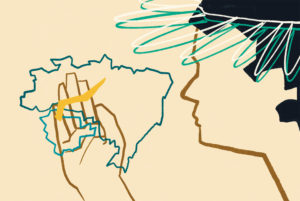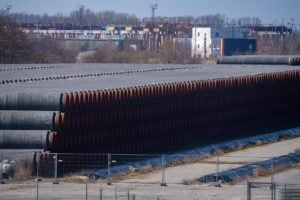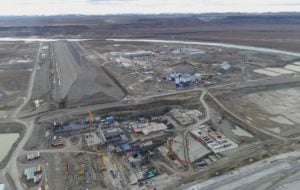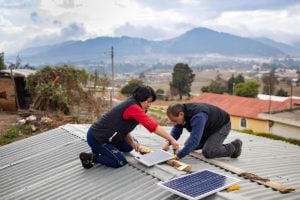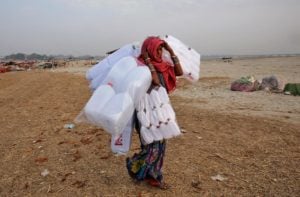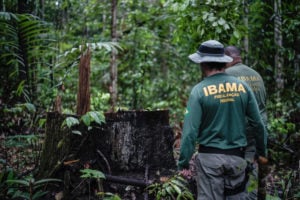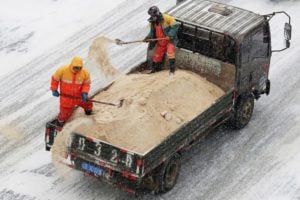On a hot August day in the city of Guajará-Mirim, in Brazil’s Rondônia state, more than 140 people packed into a training centre for a consultation on a proposed hydroelectric project – one that has rekindled debates on power plants in the Amazon, as concerns over climate change, energy security and the plant’s socio-environmental impacts collide.
Representatives from the electricity sector and the government had come to share the first studies for the so-called Ribeirão dam, a binational initiative between Brazil and Bolivia targeted on the Madeira River, which divides the two countries just north of the city.
As a spokeswoman from Brazil’s Ministry of Mines and Energy opened the presentation, protests broke out, led by around 40 demonstrators from traditional communities and organisations representing them. “No to the Ribeirão hydroelectric dam! Water for life, not death!” read one of their banners. The protestors complained of a lack of participation and transparency in the preparation of these preliminary studies for the hydroelectric project. The organisers responded by ending the event, a decision they said was made “for security reasons”.
Gerônima Costa, president of Z-2, a local fishing community, said she had only received the official invitation to attend on the same day as the meeting, and reported that representatives at the event then told them “the study had already been done”. “We weren’t needed to approve anything,” she added. “What kind of work is this that doesn’t listen to the community?”
Local dissatisfaction with the hydroelectric project had been expressed earlier in an open letter addressed to the presidents of both countries, Luiz Inácio Lula da Silva and Luis Arce, dated 30 July 2023, and signed by 37 civil society organisations. “Summoning communities to publicise studies made without society’s prior knowledge… is to violate the participation of the peoples to be affected and to hide the synergistic and cumulative impacts that will affect them,” they wrote.
Indigenous leaders, fishers, scientists and those who live off the land told reporters of common fears surrounding the project: the loss of ways of life and the collapse of ecosystems.
Amazon hydroelectric plants
The Madeira River is fundamental to the balance of the Amazon basin. It stretches over 3,300 kilometres from its source in the Andes Mountains in northern Bolivia to its mouth on the Amazon River in Itacoatiara, in Brazil’s Amazonas state. This turbid, nutrient-rich river is a home to much of the biome’s aquatic biodiversity, including 60% of fish species, and contributes around half of the sediment that reaches the Amazon River.
Despite this, the Madeira River is suffering from a range of anthropogenic impacts, linked to land grabbing, deforestation, farming, illegal mining and dams.
Following the protests, a series of meetings took place in the second half of 2023 to discuss the consequences of the project, which would be the third hydroelectric facility on the Madeira River. The other two – Santo Antônio, in Porto Velho, and Jirau, in the Jaci-Paraná district – can already contribute as much as 6.7% of the electricity that makes it onto the national grid.
Jirau and Santo Antônio are run-of-river dams, which means they rely on the natural energy of the river to move their turbines, rather than water held in a reservoir. “The effect of these dams on the hydrological regime is minimal,” said Javier Tomasella, a researcher at Brazil’s National Institute for Space Research (INPE), but he explained that the technology is more vulnerable to the climate.
In recent decades, climatic events on the Madeira River have been “like a pendulum”, according to Tomasella, going from one extreme to the other, between intense floods and droughts.
“These extremes, especially the ebbs, conspire against hydroelectric plants,” given their design to work without large reservoirs, said Tomasella. In October 2023, the Madeira River experienced a critical water shortage driven by the El Niño weather phenomenon, and the Santo Antônio plant had to suspend operations for 14 days.
“Hydroelectric dams are becoming less and less reliable in the north of the country,” claimed Natalie Unterstell, president of the Talanoa Institute, a Brazilian environmental policy organisation. She said this is because these facilities “have been or are being built in areas where the flow systems or rainfall patterns have changed.”
Hydroelectric plant studies
In November 2016, Brazil and Bolivia signed an agreement to begin preliminary studies on a binational hydroelectric project in the Madeira Basin, in an agreement between the then Brazilian state-owned Eletrobras, privatised in 2022, the Bolivian state-owned ENDE and the CAF Latin American Development Bank.
The studies propose the construction of two dams: the Ribeirão, so named for its position at the meeting of the Ribeirão stream and Madeira River, between Nova Mamoré, Brazil, and Nueva Esperanza in Bolivia; and a second at the meeting of the Yata and Mamoré rivers, between Guajará-Mirim and Guayaramerín in Bolivia. The planned flooded area is 319 km2 – 176 km2 of which situated in Bolivia, and 143 km2 in Brazil. On both sides of the border, this would affect conservation and wildlife areas, and historic heritage sites, as well as ecosystems in Bolivia’s Ramsar-listed Rio Yata wetlands, home to 24 species of threatened animals, such as the giant otter.
João Dutra, a member of the Movement of People Affected by Dams (MAB) and Brazil’s National Human Rights Council, believes that the studies were carried out “unilaterally”. “Guajará-Mirim was once considered the greenest municipality in Brazil. Much of it is forest and traditional community land,” he said.
Ninety per cent of Guajará-Mirim’s area is estimated to be covered by forests, mainly concentrated in a mosaic of conservation areas and Indigenous territories.
For the project to go ahead, the preliminary studies need approval from both the Brazilian and Bolivian sides. Then both countries need to sign new agreements for the next stage, which involves in-depth engineering, socio-environmental and economic studies, with an estimated timeline of six years.
Indigenous peoples on alert
The Igarapé Ribeirão and Igarapé Lage Indigenous lands are the closest to the proposed dams. While the companies claim that these areas will not be flooded, the Indigenous peoples may have reason to be on alert: an analysis found that the Jirau and Santo Antônio dams have flooded 64.5% more land than originally planned.
“We’re very worried,” says Arão Oro Waram Xijeim, a leader from Igarapé Lage. “The flooding will be greater than predicted in the study and will directly affect the social organisation, food, culture and health of the region’s Indigenous peoples,” he claims.
They are extremely important rivers for our region, for transporting our produce and, above all, to catch fishArão Oro Waram Xijeim, Indigenous leader
This Indigenous land is home to 783 people and extends over 107,000 hectares on the border between the municipalities of Nova Mamoré and Guajará-Mirim. Igarapé Ribeirão, meanwhile, has 289 inhabitants and 48,000 hectares, all located within Nova Mamoré.
“The Mamoré and Madeira are extremely important rivers for our region, because we use them to transport our produce and, above all, to catch fish to eat,” said Arão Oro. “They’re going to build that Ribeirão power station over there, it’s going to have an impact here.”
The studies recognise that a projected increase in migration due to the works could “cause changes to existing ways of life” and “increase conflicts associated with land use and the exploitation of natural resources”. “Brazil’s Indigenous and traditional populations,” the text continues, “are the most sensitive to changes in rivers and natural environments and to the arrival of new people around their territories.”
In its response for this report, Eletrobras said that the studies “are based on secondary data and only present an estimate of the probable human groups affected.” (Full response available here.)
The company added that there has been “permanent communication with public and private institutions and the general population of both countries” since the start of the studies. An information centre in Guajará-Mirim operated from March 2018 to May 2020, and “fortnightly visits to the communities” and “clarification meetings” were promoted, such as the consultation in August 2023.
Flooded rubber plantations
Although the studies foresee “marginal flooding” in protected sustainable production areas known as “extractive reserves”, local leaders said they had not been approached.
“We know that there was a company that set up shop and carried out the study for two years, but at no point did it sit down with us extractivists to talk about what it thought was going to happen to us,” says Ronaldo Lins, president of the Primavera Association, a group representing producers in the Pacaás Novos River extractive reserve, to the south-east of Guajará-Mirim.
The reserve is home to around 200 families who make a living from rubber and Brazil nut production. Born in 1973, Lins used to accompany his father when he was still a child to collect rubber and remembers kindling an early love for the forest. “There wasn’t much deforestation, there was no fire,” he said of the time.
The river that gives the reserve its name – a tributary of the Mamoré River that itself flows from the Madeira – is the producers’ main route to the collection sites and the transport of their produce to the city.
“If this plant in Ribeirão really happens, with these two dams, it will be very worrying for us. We’re totally against it,” added Lins. “The Pacaás is the most important river for us to transport our products: rubber, nuts, flour. It’s our road.”
Meanwhile, in the 204,000-hectare Ouro Preto River reserve, east of Guajará-Mirim, 270 families work collecting Brazil nuts, açaí and rubber, among other small-scale activities, including farming.
Edvaldo da Costa, president of the Association of Rubber Tappers and Agro-extractivists of the Lower Ouro Preto River, also criticised the project: “We have a consultation protocol. They know where the traditional population is and how we want to be consulted.”
In both reserves, rubber is collected during the dry season, from May to November. When the rains come, from December to March, the producers move to the chestnut groves on firmer ground, and also collect açaí. However, recent flooding has lasted up to two months and shortened the rubber harvest. The prolonged flooding also affects their family farming initiatives. If they remain flooded for too long, rubber and açaí trees are unable to survive, as Lins described in the case of the Jaci-Paraná extractive reserve, following the creation of the Jirau and Santo Antônio hydropower plants.
“They’ve lost a large part of the rubber plantations because the water invaded and took a long time to dry up,” says Lins. “If we’re already having problems when the water recedes here in July, imagine if they build another plant.”
Impacts on fishing
The Upper Madeira is a region with little human presence, which contributes to a preserved forest and a river with ample aquatic biodiversity.
“The species that are in the Guaporé and Mamoré rivers are able to fulfil their physiological migration process, there are no dams to stop them,” said biologist Carolina Doria, coordinator of the Ichthyofauna and Fisheries Laboratory at the Federal University of Rondônia.
The studies for the proposed dams describe potential impacts on aquatic habitats, changes in the dynamics of sediment transport and a reduction in river connectivity, with the formation of barriers to biological flows. Fishers were not mentioned in the studies, nor in the presentation on the official website for the binational project.
Gerônima Costa was born in the rubber plantations in the interior of Guajará-Mirim in 1962, to a family that made their living from rubber and fishing. She said that an overflow of the Mamoré River in 2014, caused by the operations of the Jirau hydroelectric plant, left several neighbourhoods underwater and affected the headquarters of the Z-2 community.
The fishers were compensated by the company that manages Jirau, but Gerônima does not want a repeat of the experience: “Our town has become like an island. Water came in everywhere. We have to respect our reserves and Indigenous areas.”
Fish farming ponds in Bolivia have also collapsed, and fish such as the pirarucu have spread into local rivers, preying on a number of species that are important in both the trade and diets of local residents.
Just transition
Multiple interviewees for this report complained that the existing hydroelectric dams on the Madeira River produce electricity for the grid, often destined for beyond Rondônia, while in local municipalities energy is expensive and often from dirty and intermittent sources.
“This hydroelectric complex invested in, realised and built in Brazil was made for the national system. It was never designed to supply the Amazonian population,” said Natalie Unterstell. “This is proof of environmental racism,” she claimed.
At the Z-2 fishing community headquarters, the monthly energy bill is around 1,000 reais (US$200). At its fish market, which hosts a cold room and ice machine, it’s around 4,000 reais. “The hydroelectric plants are not for us,” says Gerônima Costa.
In Brazil’s Legal Amazon, the official region comprised of nine Amazonian states, there are 211 isolated electricity systems, those that are not connected to the national system. Around 80% of energy in these systems is estimated to come from diesel-fuelled sources. In 2022, these sites consumed 857,900 cubic metres of diesel oil, producing almost 3 million tonnes of carbon emissions, according to figures from the Ministry of Mines and Energy obtained by via Brazil’s Access to Information Act.
In the Pacaás Novos River extractive reserve, each family has its own diesel generator and spends up to 400 reais (US$80) a month to have power for four hours a day. Some of those who have made a profit on their harvests have begun to invest in solar panels, “to have a fridge, to have energy for their own home, to switch on a television,” said Ronaldo Lins.
But that should soon change: producers on extractive reserves hope to be served by the federal government’s Light for All programme by March this year.
Some photovoltaic panels have already arrived at the Ouro Preto River reserve. Each consumer pays a monthly fee of 60 reais (US$12), according to Edvaldo da Costa. “Those people who live two or three days away from the city now have their own energy, their own fridge. It’s changed a lot, for the better,” he added.
“When it comes to food, people used to salt meat to dehydrate it, and now it’s preserved in ice. Even for their own health, it helps a lot. Drinking cold water – not many people had that privilege. The whole community is happy.”
This story was first published by ((o))eco. This version has been translated and lightly edited with permission for an international readership.
